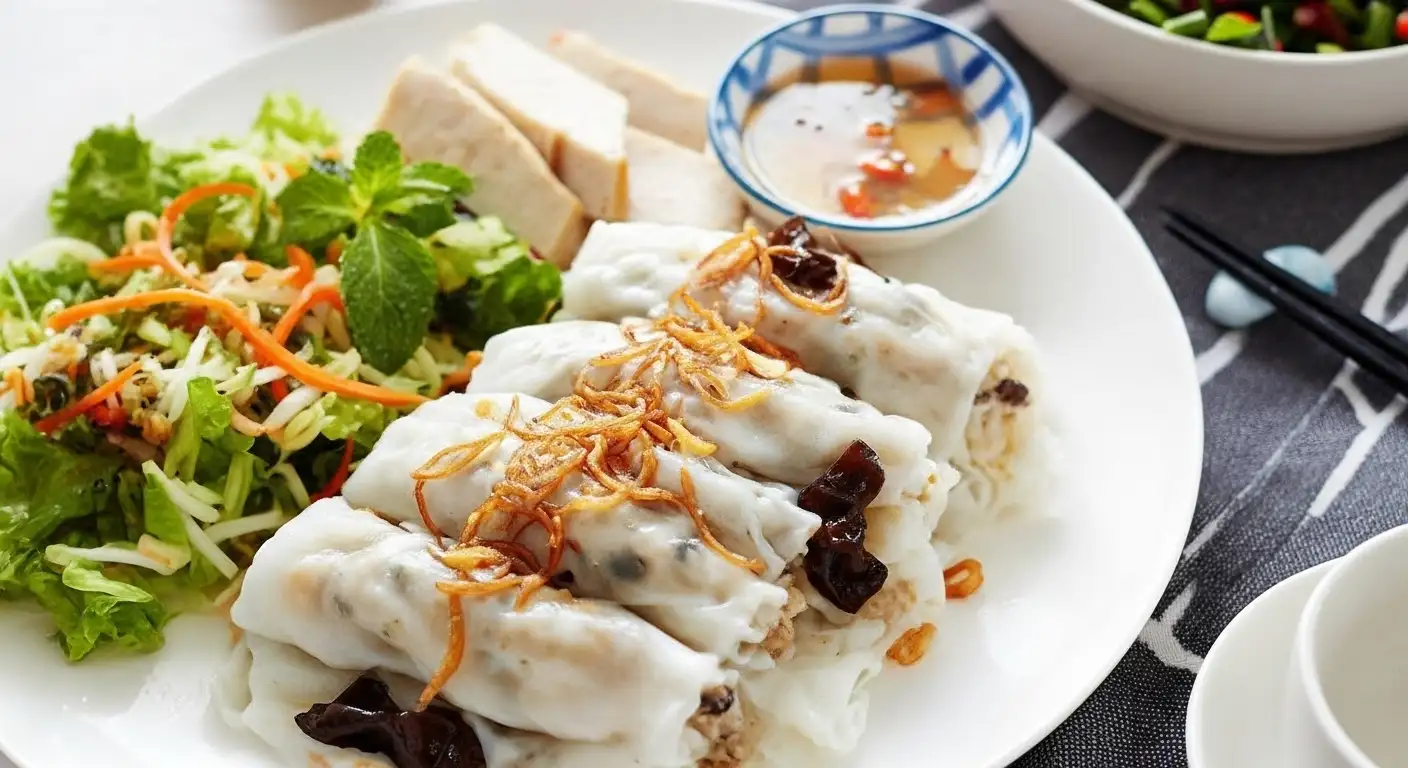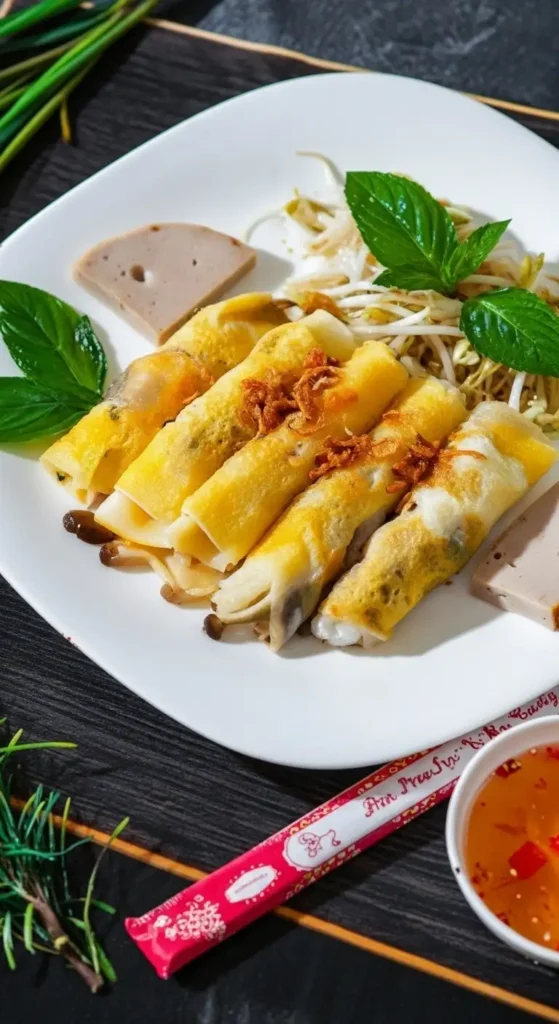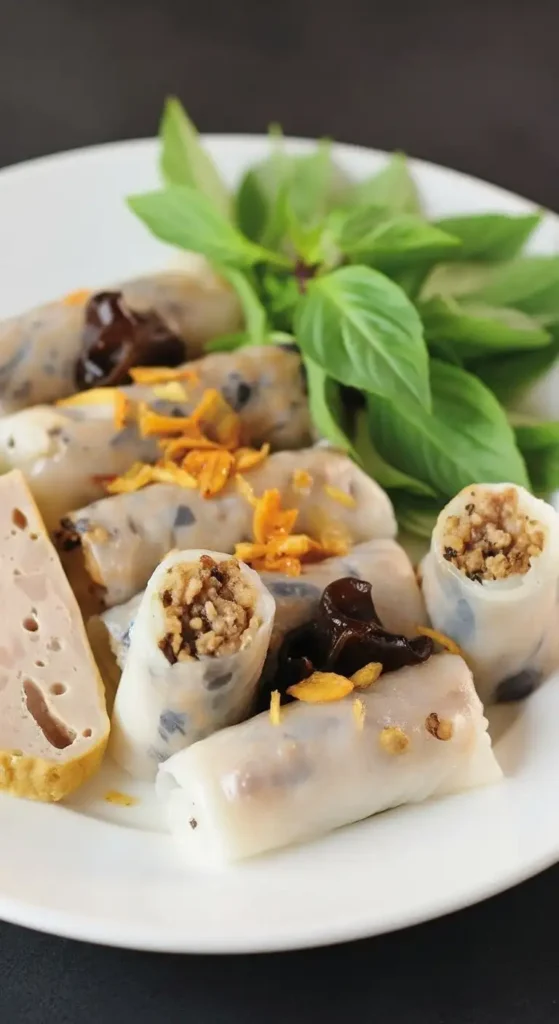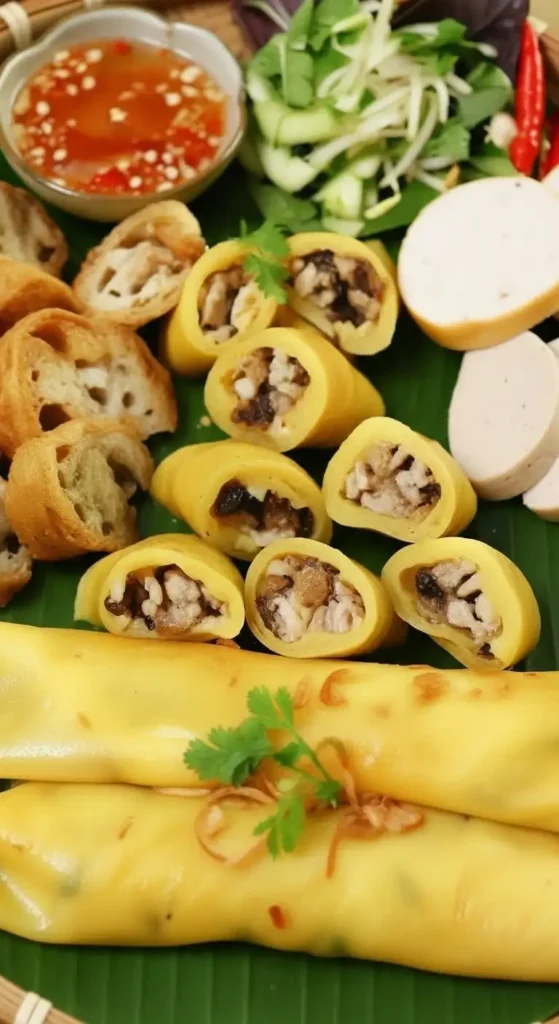Bánh Cuốn is a beloved Vietnamese dish of delicate, steamed rice noodle rolls. Originating in Northern Vietnam, particularly the Thanh Trì area of Hanoi, it is a testament to the simplicity and refinement of Northern Vietnamese cuisine.
The dish is defined by its incredibly thin, silky, and almost translucent rice paper sheet, made fresh by steaming a rice batter over a thin piece of cloth stretched across boiling water. Often enjoyed as a light breakfast or a satisfying mid-day snack, Bánh Cuốn offers a delightful contrast of textures and subtle, aromatic flavors.

Bánh Cuốn: The Basics
The Wrapper (Bánh): This is the soul of the dish. It is made from a batter of fermented rice flour and water (sometimes with a little tapioca starch for elasticity). This batter is ladled onto a cloth steamer and cooked for mere seconds until it forms a gossamer-thin sheet. It is then gently removed with a bamboo stick, often right in front of the customer.
The Roll (Cuốn): The thin sheet is traditionally filled with a savory mixture of finely seasoned ground pork, minced wood ear mushrooms (nấm mộc nhĩ), and sautéed shallots. The sheet is then quickly rolled up to create a warm, tender log.
The Garnish: A serving of Bánh Cuốn is always topped with generous sprinkles of golden-brown fried shallots (hành phi), which add a crucial, fragrant crunch.
The Dipping Sauce (Nước Chấm): This dish relies heavily on its accompanying fish sauce dipping sauce. Unlike the sauces for Southern dishes, the Northern Nước Chấm for Bánh Cuốn is often characterized by a light, warm, and mild flavor, offering a perfect balance of salty, sweet, and sour without being overly concentrated. Sometimes, a drop of chili oil is added for a little heat.
Varieties of Bánh Cuốn
The main variations of Bánh Cuốn stem from the filling and the accompanying side dishes, often resulting in dramatically different culinary experiences.
| Variety/Type | Key Feature | Description |
|---|---|---|
| Bánh Cuốn Nhân Thịt | Classic Pork/Mushroom Filling | The standard, traditional roll filled with seasoned ground pork and wood ear mushrooms. |
| Bánh Cuốn Thanh Trì | Plain Rolls (Unfilled) | Hailing from the original village in Hanoi, these rolls are unfilled—just the plain, delicate rice sheets, served with fried shallots and the dipping sauce, often alongside various sliced Vietnamese sausages. |
| Bánh Cuốn Trứng | Egg Filling | A popular variation where a whole egg is cracked onto the thin rice sheet while it steams, creating a tender, egg-laced roll. |
| Bánh Ướt | Wet Cake" (Unfilled) | While structurally similar, Bánh Ướt refers to the plain, unfilled, flat rice sheets which are common in Central and Southern Vietnam. They are often cut and served with grilled meat (Nem Nướng) or Chả Lụa. |
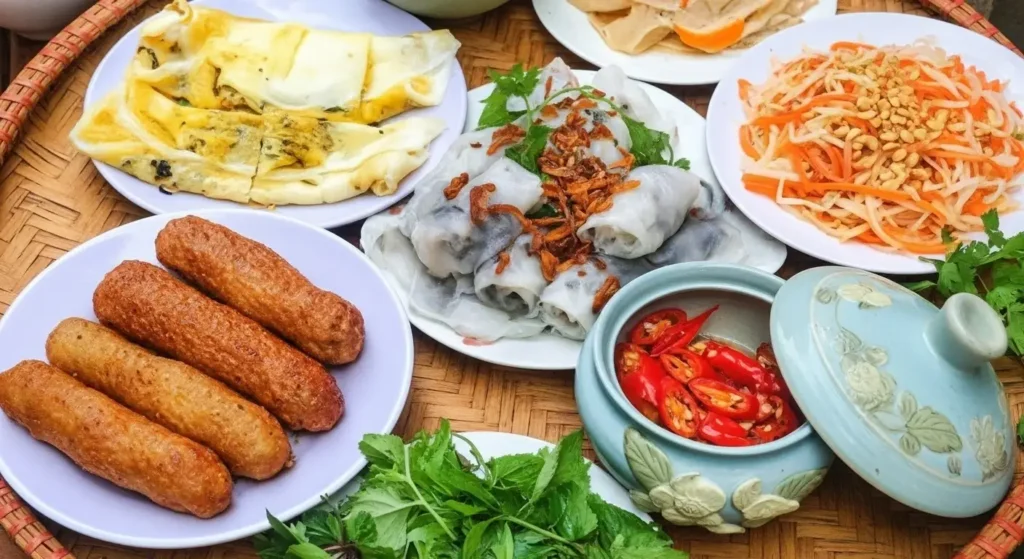
How to Eat Bánh Cuốn
Bánh Cuốn is typically a communal, warm dish eaten quickly while the wrappers are still warm and silky.
Drench, Don’t Dip: Take a few pieces of the rolled Bánh Cuốn and place them directly into your bowl of warm Nước Chấm. Unlike spring rolls, where you might dip piece by piece, many locals prefer to let the sauce soak into the delicate rolls.
Add Sides: Scoop up slices of the savory accompaniments—Chả Lụa (steamed pork sausage), Chả Chiên (fried sausage), or Nem Chua (fermented pork)—and mix them in the dipping sauce.
The Perfect Bite: Ensure your spoonful contains a piece of the soft roll, a chunk of the savory sausage, and a few slivers of fresh herbs (like cilantro or mint) and blanched bean sprouts for a clean, refreshing crunch.
Special Note for Bánh Cuốn Làng Kênh (Central): In some Central provinces, the dish is served with a unique, rich pork bone broth instead of the traditional fish sauce, a very different and hearty experience.
Regional Differences
Bánh Cuốn originated in the North and its regional variations largely follow the general culinary trends of each region.
| Region | Dipping Sauce & Flavor Profile | Key Distinctions in Serving |
|---|---|---|
| North (Hanoi) | Mild, light, and warm Nước Chấm. The most subtle and balanced flavor profile, with emphasis on the pure taste of the rice. | Served with minimal herbs (mostly cilantro/mint) and various pork sausages (Giò Lụa, Chả Quế). The roll itself is extremely thin and delicate. |
| Central (Miền Trung) | Spicier dipping sauce, sometimes with fermented shrimp paste, or a pork bone broth (e.g., in Cao Bằng). | Often served as Bánh Ướt (unfilled sheets) with grilled meat (like Nem Nướng) or eel soup/congee, showing influence from other local dishes. |
| South (Saigon/Mekong Delta) | Sweeter and bolder Nước Chấm. The dipping sauce is often richer, reflecting the Southern preference for sugar and sometimes coconut milk. | Served with a more liberal assortment of fresh herbs and vegetables. The roll wrappers may be slightly thicker or larger to accommodate more filling or to include shrimp or jicama in the filling. |
